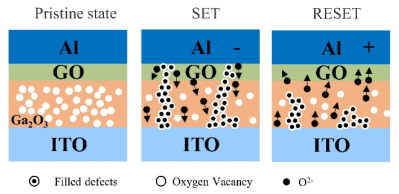Resistive random-access memory (RRAM) is a highly attractive form of RAM, as it promises low-power usage with stable long-term storage, even in the absence of external power. Finding the right materials to create an RRAM cell which incorporates these features is however not easy, but recently researchers have focused their efforts on gallium(III) oxide (Ga2O3), with a research article by [Li-Wen Wang] and colleagues in Nanomaterials describing a two-bit cell (MLC) based around an aluminium-gallium oxide-graphene oxide stack which they tested for an endurance of more than a hundred cycles.

The way gallium-oxide works in an RRAM cell is by forming a conductive filament formed by oxygen vacancies. These vacancies and the resulting conductive path are controlled by an externally applied current via the top (Al) and bottom (ITO) electrodes, with the graphene-oxide (GO) layer acting as a source of oxygen ions.
In related research, [Zhengchun Yang] and colleagues described in a 2020 article in Ceramics International how they constructed a device consisting out of gallium(III) oxide RRAM data storage with a piezoelectric ceramic element that served both as pressure sensor and power supply. The current generated by the piezo element is used to power the memory device and record measurements.
Then there is the somewhat more wild ‘FlexRAM’ idea pitched by [Ruizhi Yuan] and colleagues in Advanced Materials who describe how they created a device consisting out of flexible polymer called ‘EcoFlex’ with pockets in it for a ‘liquid gallium-based metal’ to create a flexible memory device. At millimeter-sized structures it’s hard to see practical applications for this technology, even if the associated PR article in IEEE Spectrum goes pretty hard on breathless speculation.

















I know this is experimental, but a hundred cycles? That would last about a microsecond in a modern computer!
A 100 cycles of what is also important. Is this a 100 writes and then the device is broken? That’s worse then any EEPROM.
If it’s a 100 read cycles before it needs to be re-written as the data is lost, that’s better then DRAM.
If it’s a lot or not depends on the context.
Also retention lifetime is important. Even if each cell can only be written 100 times before it effectively dies so long as the data is good for a long time after power removal this could still be valuable as a write once/infrequently but read many backup medium.
The point of RRAM is indeed extremely long data retention and low power demand, and the fact that it scales down to much higher data densities, so while it may not survive many write cycles it’s perfect for storing firmware in devices that can be updated sometimes.
EEPROM can keep data for a hundred years if kept cool, but it’s more expensive and less dense than flash which loses data in just a couple decades. This could be denser and cheaper than flash AND keep data for a hundred years.
Gallium oxide deposition is fickle, a more refined cell would have a massively more complex stackup, but you have to start somewhere.
See above comments plus graphene.
While interesting, this is much like the 98% efficient solar cells in single wavelengths. We won’t be seeing them in the consumer market any time soon (though the solar cells are probably closer than this since they lack graphene)
This is much like the mouse model disclaimer that needs to be placed on many medical research papers, this needs to have the “Graphene” disclaimer
I would think that a highly efficient wavelength-specific solar cell would still be useful in something like concentrated solar. Focus down on a small target that collimates the beam and then pump the beam through a prism to extract useful energy from the proper wavelength of light. It seems like it would possibly work in an agrivoltaic setup, with some of the light being siphoned off to illuminate plants and some used to generate electricity.
Of course, that’s not what _I_ would use it for. It would make for an amusing way to power tethered drones. Beam a laser up a fiber-optic link for power, modulate it for control and/or bandwidth (since you’re likely to be using a tethered drone as an antenna) and use another laser as a downlink. You now have an antenna or observation platform that doesn’t provide a very conductive path to ground.